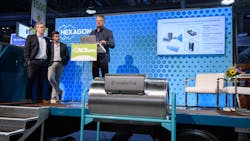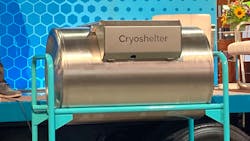Hexagon expands clean-fuel options for commercial trucks
LONG BEACH, California—As fleets seek alternative fuels to meet varying sustainability targets, renewable natural gas—in liquid or gaseous form—could be the answer for immediate heavy-duty truck emissions reductions.
When considering ways to store energy on a commercial vehicle, however, Hexagon Composites, which manufactures clean-fuel solutions for various applications, is completely agnostic.
“Whether it’s natural gas, battery-electric, or hydrogen, it doesn’t matter to us because there are different solutions for different applications that make sense to our customers,” Todd Sloan, EVP of systems for Hexagon Purus, told FleetOwner during this year’s Advanced Clean Transportation (ACT) Expo.
Hexagon provides compressed natural gas (CNG), including renewable natural gas (RNG), compressed hydrogen and battery-electric systems as part of its clean-energy portfolio. Hexagon Agility is the group’s near-zero emission leg and focuses on natural gas solutions for the commercial vehicle sector. In December 2020, the corporation spun out Hexagon Purus, which is focused on producing zero-emission hydrogen and electric vehicle (EV) solutions.
For commercial fleets today, Sloan said there is no question that renewable natural gas makes the most sense in terms of total cost of ownership (TCO). The systems, he added, are cross competitive to diesel, with the cost at the pump these days much more competitive than diesel.
See also: Cummins details 15-liter natural gas engine at ACT Expo
During ACT Expo, Hexagon Composites announced it will acquire a 40% stake in Cryoshelter GmbH, a company based in Austria that specializes in the development of cryogenic tank technology for liquid natural (renewable) gas (LNG) and liquid hydrogen (LH2).
In liquid form, RNG has a high energy density. Cryoshelter’s technology will leverage this energy density to better utilize vehicle frame rail space and provide a driving range that is comparable to diesel, the company noted.
The Hexagon and Cryoshelter partnership will industrialize Cryoshelter’s existing LNG technology and production capability and use the LNG technology platform to further develop LH2 solutions for heavy-duty transport, according to Hexagon.
“LNG specifically is really about energy density, so when you go cryogenic, if you look at a diesel application, compressed natural gas takes about four times more space to store the same amount of energy on a vehicle,” explained Eric Bippus, SVP of global sales and marketing at Hexagon Agility. “Cryogenic is twice as energy efficient as compressed natural gas, and the same holds true for hydrogen natural gas. For applications where there is limited space, LNG is required.”
The partnership allows Hexagon Composites to fill out the current known energy types that are used for targeting zero and near-zero emissions with a portfolio that the company doesn’t currently have.
Hexagon also intends to further develop the technology and scale up the business over the coming years, company executives said during an ACT Expo press conference. The transaction is expected to close by the third quarter of 2022.
The road to zero emissions
For Hexagon Purus to come out with a zero-emission product that will compete with natural gas, Sloan explained that the company has a lot of work to do.
“One, with compressed hydrogen, we can put around 70 kilograms of hydrogen in the same amount of space that Agility can put 175 diesel gallon equivalents of natural gas,” Sloan indicated. “That 70 kilograms of hydrogen would go about six to 10 miles per kilogram and then you get your range.”
“That’s great,” he added. “We can see ourselves getting to 500 to 600 miles zero emission with a solution like that, but not beyond. Now, when you take that same system and put a liquid hydrogen system on it, then that doubles in range and we are going up over 1,000 miles.”
That is why the company is working with Cryoshelter to fill the void that was missing from Hexagon’s arsenal of offerings.“Long term when you think of our customers, our job collectively is to come up with a solution that meets their needs,” Sloan explained. “That solution is going to change depending on where you are in the world; what your charging infrastructure is like; having access to cheap, clean electricity; and having access to renewable natural gas. We aren’t trying to have one technology sell over the other.”
Bippus said he gets the “what should I go with” question a lot from fleets. His answer to that question is it will be an evolution over 20 to 25 years.
“We can start immediately with renewable natural gas and add significant carbon intensity reduction for the fleet,” Bippus told FleetOwner. “A lot of that technology around renewable natural gas and biomethane in Europe is going to transform into hydrogen and EV solutions.”
“With cryogenic, you are going to have compressed stored fuel that starts with natural gas and goes into compressed hydrogen,” he added. “It’s a journey that can start today. As the infrastructure develops and as the fuel becomes cleaner and you go from today’s state of brown hydrogen to green hydrogen in the future, it’s an evolution that will take place.”
Overall, Hexagon’s goal is to make sure the company is able to store that energy today and well into the future. Ultimately, the journey starts with the fleets.
“You have leaders like Waste Management, UPS, and Frito-Lay that are really out front ahead of the rest of fleet purchases in North America,” Bippus said, noting that 98% of the heavy-duty trucks in the market today run on diesel. “So, there is a lot of opportunity today, and fleets are waiting, but they don’t need to wait. Today, deployable in mass, renewable natural gas is the best for TCO. As the grid for electricity and hydrogen improves, it will shift.”
Looking out farther ahead to 2050, Hexagon believes that natural gas will still be a big piece of the pie.
“This is not a steppingstone technology,” Sloan said. “There will be a lot of RNG out there. The thing that gets displaced is diesel, but it will be replaced by renewable natural gas, hydrogen, EV, all of it.”
About the Author

Cristina Commendatore
Cristina Commendatore is a past FleetOwner editor-in-chief. She wrote for the publication from 2015 to 2023.

